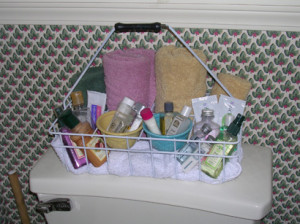When I was in grad school, I lived in a cheap, affordable, craphole of an apartment. I mean, my roommate and I did the best we could with our mismatched, hand-me-down furniture, lack of ability to paint or modify anything, and general lack of any interior design skills. But, when it all boils down to it, the place was hideous. Thankfully, we had friends and family who liked us enough to see past the eye sore of our living quarters and just enjoyed hanging out with us.

Had we chosen to do so, we probably could have spruced the place up a bit (sadly, we were too lazy and didn’t spend enough time at home to care that much) and made it a little more…presentable. Although we didn’t have a ton of money to spare, we probably could have taken about $20 and a trip to the dollar store (or a place like Walmart) and made some pretty decent adjustments. If I knew then what I know now, here’s what I would have done:
- Candles. Not only do candles smell great (for the most part), they provide little pops of color that can make a bland, drab apartment seem a little more inviting. Color brightens up a day and a mood and, if your apartment has a funk that you just can’t get rid of, the smell from the candles might cover it up. The price of the candles will depend on the size you buy but I’ve found that the smaller ones do just fine (and you don’t have to commit to a scent for too long if you don’t like it!)
- Flowers in vases. Fake flowers, of course. Fresh flowers are expensive and hard to care for but the fake ones? Perfect. Create a bouquet of your favorite colors, place them in a plastic or glass vase that you set on your dining table, coffee table or kitchen counter and voila! Instant change to a room. Plus, the flowers are inexpensive enough that you can change them with the seasons and not spend a fortune (also, they don’t die so you can reuse them).
- Pictures or art work. Professional prints can cost a pretty penny so why not create your own? Online sites like Snapfish and Shutterfly often have great coupons and discounts on pictures. Upload a few of your favorites (can be of family, friends, sunsets…whatever makes you happy), order them in a variety of sizes, purchase inexpensive dollar store frames (who’s going to know the difference?) and hang them on the walls. This can definitely make a place feel more like home.
- Storage boxes. Or bins or trays or whatever. The dollar stores sell a wide array of fancy looking storage containers. Pick up a few of those and use them to store (and display!) your books, makeup, magazines, TV remotes, board games or whatever personal touches you have in your apartment. Not only does it make a place look cleaner (which definitely helps make it feel less awful) but these again provide some color and shows off your creativity! You can also get some photo boxes at craft stores, and those are not too pricey, either.
- A vision board. Put anything on it you want—vacation ideas, your plans for your dream house, ideas for a wedding or kid’s room; pretty much anything that will inspire you. Don’t have the supplies? Glue and poster board are cheap. Ask co-workers, friends, a doctor’s office or the library if they have old copies of magazines they’re willing to donate to you. Use markers if you’re hesitant to ask. Then, when you’re done, hang it somewhere conspicuous. This serves two purposes—you’ll look at it to keep you motivated and when you have visitors, it’s a great conversation piece.
Two other suggestions I have for making a not so wonderful apartment (or house) feel a little less awful. The first is this: don’t compare yourself and your situation to what other people have. You don’t know where they came from, why their current house looks the way it does (they could be stellar at finding flea market deals and fixing things up, for example), how much money they have, or even if the decorating was a gift from a friend who was working on a school project. Comparing your interior design to someone else’s is a surefire way to feel depressed, angry and resentful (on the other hand, you can also use it as motivation or for ideas).
The second suggestion is this: Leave. Take a walk. Go to the library. Visit an animal shelter. Window shop at a thrift store or yard sale (or take a few dollars. You might find something great for your place!). It doesn’t really matter where you go, just get out. Spending all your time inside a home that makes you feel bad will only dampen your mood. Even people with the most perfect houses leave them from time to time. Because no matter how much you hate where you live, there’s still something a tiny bit comforting about coming home.
Especially if you’ve made it a little more inviting. This is your home, not matter how temporary or permanent, it’s where you’re living. There are a number of adjustments you can make for a very little sum of money to make it more pleasant during the time you’re there. So why not give it a shot?
Readers, what are some ideas you have for decorating on a budget?



